The Jingler fly has secured its place on my list of top 10 dry flies due to its exceptional track record in enticing early-season brown trout. Its effectiveness has been consistently proven over the years, making it a reliable choice for fly fishing enthusiasts.
Anglers who have experienced the Jingler’s success firsthand consider it a staple in their fly boxes, ensuring they are well-equipped to tackle any fishing conditions.
Nowadays in March and April, the…
Jingler fly is the 1st dry fly I will try.
This pattern’s ability to imitate natural insects on the water’s surface is remarkable, triggering strikes from even the most elusive trout. Especially when large dark olives and brook duns are hatching and being taken by hungry over-wintered brown trout.
How to tie the Jingler fly?
Tying material list:
- Hook: Kamasan B170 #16 & 12
- Thread: Olive 8/0 Uni-Thread
- Tail: Badger cock fibres
- Body: Hends body quill BQ-32
- Rear hackle: Ginger cock
- Front hackle: Grey partridge
Tying instructions:
Unlike many trout dry fly patterns, it works and floats best when tied scruffy because its buggy appearance makes it more attractive to trout. The following step-by-step guide explains how best to tie this fly.
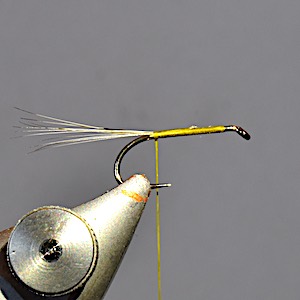
Step 1. Catch the olive tying thread onto the hook 2 mm behind the eye. Tie in badger cock fibres and run the thread in touching turns and stop just past the hook point.

Step 2. Tie in the Hends body quill and run the thread back towards the eye, leaving a 4mm gap to tie in two hackles.
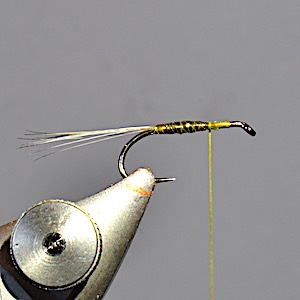
Step 3. Wind the body quill toward the eye and tie off, leaving ca. 4 mm to tie in the hackles.
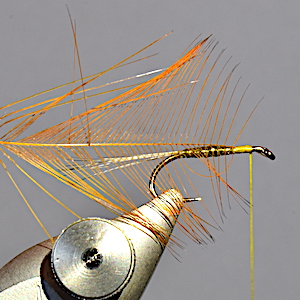
Step 4. Prepare the ginger cock feather and tie it in by its tip.
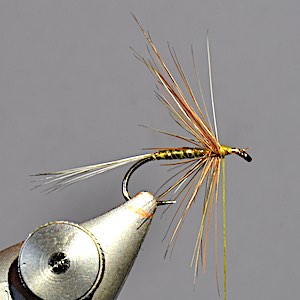
Step 5. Using hackle pliers, make 4 turns of the hackle and secure it with the thread.
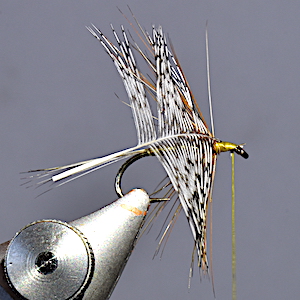
Step 6. Prepare the grey partridge feather and tie it in by its tip.
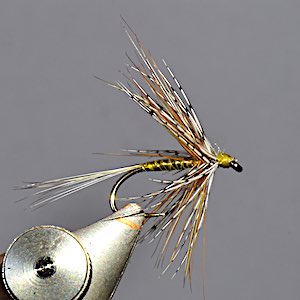
Step 7. Using hackle pliers, make 2 turns and secure the hackle with the thread. Build a small head with the thread, whip finish, and varnish the head.
Fly fishing tips for the Jingler fly
When fishing the Jingler fly during the brown trout season on the Welsh Dee, it is important to target areas where fish are actively rising to species such as large dark olives and brook olives.
Equipment-wise, I use a 9ft 5# rod for dry fly fishing. Attached to the floating line is a 9ft 5X copolymer leader tipped with a 3 to 4 ft length of 4lb fluorocarbon. Fuller’s mud is applied to the fluorocarbon tippet to remove its shine and make it sink. Whereas, Mucilin grease is applied to the remainder of the leader so that it floats.
The fly should be presented in medium to fast-flowing water, particularly at the heads of pools, allowing it to drift naturally over the feeding fish. To withstand the potentially aggressive takes, it is advisable to utilize a robust leader with a breaking strain of 4 to 5lb.

For more on fishing for brown trout with dry flies check out the following post on…
Stalking trout with the dry fly.
Finally, I hope this article on tying the Jingler fly stimulates you to test it on your local river or stream.
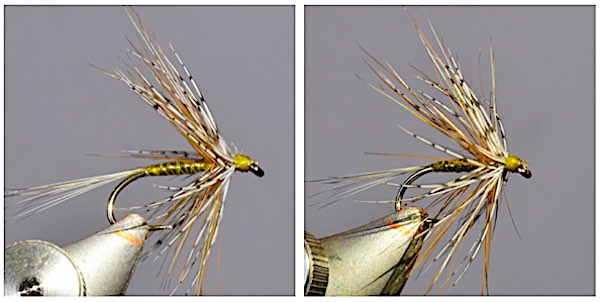
Lovely looking fly Andrew would you fish it in the surface film semi emerging or sitting proud , I’ve never heard of it before got the look of a wet mayfly about it .
Hi James,
The answer to your question is all three.
Normally, I start by fishing it proudly on the surface, especially when the LDOs are being intercepted when they are waiting for their wings to dry.
On warmer days when LDO are leaving the water immediately after emerging, fishing the fly in the surface film or just under the surface can be more productive. NB. if the fly sinks don’t be in a hurry to recast it because will often take the submerged fly.
I hope this helps, Andrew
Would you fish this single fly or a team ….cheers
I normally fish it as a single dry fly but there no reason why you couldn’t fish with a dropper.
Andrew
nice tie again andrew
Hi James,
I glad you enjoyed the article. It’s part of a new section on fly tying I’m adding to the website. So there will be a few more posts in the coming weeks on tying my favourite flies.
Cheers, Andrew
Andrew – that looks better than any I’ve seen in available commercially!
Cheers
Nice fly Andrew I will have to try this one
Hi Steve,
It should get you a few fish this time of year.
Andrew
Andrew nice fly , I am new to your site and just wanted to know if the fly is good on the section of the Dee you fish or is it a good all-rounder on the Dee. Cheers.
Hi Gary,
The Jingler will catch fish on the full length of the Dee when large dark olives are hatching.
Andrew
I enjoyed seeing how you tie this fly must have a try. What could you substitute for the heads body quil?
Stripped peacock herl or brown olive dubbing will work
nice article! Are the trout there that wary, that you have to use such a long leader? I like a furled polyester 3 foot leader with 203 ft of Fluoro attach. Would that work there? I am using a 7&1/2′ 5wt banboo rod.
Hi Joel,
I’ve never gone that short with a leader setup. If it’s windy etc. I will drop back to a 9ft tapered leader but normally I fish a 12 – 15ft leader.
Tight lines, Andrew
In 1979 we had a Scottish guy teaching us fly tying and he used to call this type of fly bi- visible ( dark hackle followed by light hackle) I think I’ll tie a few and see how I get on , when the Dee drops a wee bit.
Hi Peter,
Definitely, worth tying a few for when the River Dee level drops back and the weather warms a little more. It won’t be long before LDO start hatching.
Tight lines, Andrew
Cracking fly Andrew and very well tied. I totally agree an excellent early season pattern. I wait in anticipation to watch one drifting down a lovely run on the Welsh Dee. Hopefully soon. All the very best.
Hi Scott,
Great to hear you enjoyed it. Hopefully, the weather will dry up soon.
Tight lines, Andrew
Having had to discard nearly 1500 flies with crushed barbs as only manufactured barbless hooks are allowed on matches now I am tying 3 or 4 days a week to bring up my boxes to their former glory and do like the look of the “Jingler” so will be giving this a go later today. As always your posts are a delight and well presented. Tight Lines, Iain.
Hi Iain,
That’s a big task. Andrew